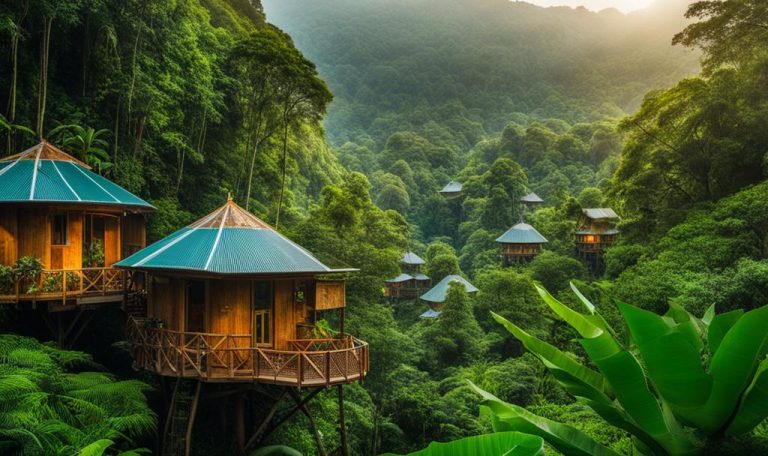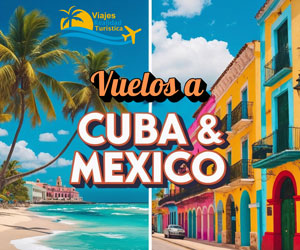On board Jurgen Stein’s two-seat gyrocopter, tourists can see the rainforest like never before. From the sky, the Selva Bananito Reserve looks like an endless stretch of broccoli.
“We have 11 life zones. Almost 5% of the global biodiversity exists here,” Stein says, pointing at the reserve that’s part of the Bosque de las Madres biological corridor.
Nestled in the Talamanca Mountains in southeastern Costa Rica, his private reserve stretches to the fringe of La Amistad International Park, the largest nature reserve in Central America that straddles more than 400,000 hectares (162,000 acres) of the border region between Costa Rica and Panama. Stein’s own reserve, a more modest 1,700 hectares (4,200 acres), was inherited largely from his father, who purchased the area in 1974 for farming and logging. But Stein refused to continue clearing the forest, and instead turned 1,250 hectares (3,088 acres) into an ecological reserve in 1994, keeping only a third of the property devoted to farming.
Selva Bananito is home to birds such as the great jacamar (Jacamerops aureus), anteaters like the northern tamandua (Tamandua mexicana) and the silky anteater (Cyclopes didactylus), and the Central American agouti (Dasyprocta punctata). It also hosts jaguars (Panthera onca) and pumas (Puma concolor). “When my father was 90, I gave him the footprint of a jaguar and a photo of a puma looking at one of our trap cameras. He stared at the picture and cried the whole day,” Stein says.
Soon after establishing his reserve, Stein realized that he needed more sources of income to make up for no longer being able to log. He and his sisters saw tourism as an alternative, and in 1995 they opened the reserve to visitors. Today, guests sleep in 11 cabins built with recycled wood in traditional Caribbean style, and enjoy hiking and horseback riding in the reserve or watching some of the 300 species of birds living here. The more adventurous can also rappel down a 24-meter (80-foot) waterfall or glide from tree to tree on zip lines. And they can fly with Stein over the forest.
Over the years, Stein has become a well-known figure in Costa Rica’s ecotourism industry, including serving as vice president of the National Chamber for Ecotourism (CANAECO) and sitting on the board of the Nature Reserves Network, which represents all of the country’s private reserves. If Costa Rica has achieved worldwide recognition, he says, it’s thanks to tourism.
Tourism and conservation go hand in hand
In Costa Rica, sustainable tourism became an essential driver of the economy in the early 1980s. “We could not compete with the beaches of Mexico and the Caribbean islands. But we realized that no one had our natural assets,” Costa Rican Tourism Minister William Rodriguez López tells Mongabay.
The country implemented several bold policies to showcase its standing as home to 6.5% of global biodiversity. In 1969, it began designating the first protected areas, reversing policies stretching back to the early 1800s that had favored forest-clearing agribusiness. These earlier policies promoting deforestation drove Costa Rica’s rainforest cover as a proportion of the country’s total land area to as low as 40% in 1987. In 1995, Costa Rica turned the tide and approved a new law banning any further changes in land use and implementing a payment for environmental services (PES) program to support private conservation efforts.
Under the PES scheme, farmers and landowners receive an economic incentive for taking care of their trees through practices such as reforestation or agroforestry. The program, is funded mainly through a national fuel tax and water charge, covers 1.3 million hectares (3.2 million acres), or about a quarter of Costa Rica’s land area, and has seen 6 million trees planted since 1997.
Together, these policies have proved successful: today, forests cover 57% of the country. According to the World Bank, Costa Rica is the first tropical country to have reversed deforestation.
Tourism has developed along the same trajectory: the number of foreign visitors has risen steadily; of the 2.7 million people coming to Costa Rica in 2023, 1.6 million, or about three in five, visited its protected areas. Tourism today accounts for 8.2% of GDP and 21.3% of the workforce, both direct and indirect, making it an essential part of the economy.
Over time, the tourism sector has implemented many measures toward greater sustainability. In the 1990s, the Costa Rican Institute of Tourism (ICT) created a third-party certified label to guarantee the social and environmental sustainability of its hotels and other ventures. Businesses looking to be certified must meet a range of criteria, including measuring their carbon footprint.
But local ecotourism operators such as Stein say they fear this blessing could soon turn into a curse. “Costa Rica should keep growing the seed it planted many years ago, which attracted the tourists here. The same tourists that today asked me how is [it] possible that they saw trucks loaded with giant trees,” Stein says.
The threat of mass tourism
During his frequent flights over the rainforest, Stein has witnessed an increased presence of deforestation since the COVID-19 pandemic started in 2020. He says he fears the subsequent economic crisis has pushed many local farmers toward illegal logging, damaging the country’s most precious asset. “It’s all for construction. Costa Rica is for sale. Ocean view, beachfront, whatever: we are selling our country to people who have money and want a second or third house,” Stein says.
In 2023, the public prosecutor’s office received 2,355 complaints of environmental crimes, most regarding damage to biodiversity, invasion of protected areas, violations of the forestry law, or illegal mining. Illegal logging is on the rise, especially in the country’s north, on its southern Pacific coast, and in Limón, the Caribbean coastal province where the Selva Bananito Reserve lies.
Stein recalls flying to the border with Panama in March 2022 and spotting a track through the forest that he’d never seen before. “I flew over there again a week later, and I could already see a bulldozer and the timber,” he says. He sent the coordinates to the authorities, who subsequently arrested a group of loggers. But simply policing the damage after the fact isn’t enough, Stein says.
He notes that the farmer who allowed the logging on his land earned the equivalent of more than $100,000 for just a week of logging. For conserving the same amount of forest, he would have earned just over $3,000 in five years.
“Extraction and destruction bring more money than conservation,” Stein says.
His concerns are shared among several of the pioneers of sustainable tourism in the country. “Massive tourism is poisonous for eco-travelers,” says Glenn Jampol, chair of the Global Ecotourism Network (GEN) and owner of the Finca Rosa Blanca Coffee Farm & Inn. Jampol moved to Costa Rica from the U.S. after buying an old coffee farm. With his mother, they decided to restore the area and rent out a few bedrooms to pay for the work. And it was a success. National Geographic magazine selected Finca Rosa Blanca as one of its Unique Lodges of the World. Jampol’s coffee was also awarded the top prize for organic coffee at the World Coffee Challenge.
But Jampol says he’s worried that, by embracing mass tourism and cruise ships, Costa Rica could lose its competitive edge in the expanding sustainable tourism industry. GEN valued the global sustainable tourism market in 2022 at $3.3 trillion, and projects it could reach $11.4 trillion by 2032. “Many believe that the more tourists, the better. But it’s a lie,” Jampol says. “It is not about the price: it’s about the value, [about] an unforgettable experience. If we follow the [mass tourism] trend, we will lose all our edge.”
From sustainability to regeneration
Even the ICT, the national tourism institute, seems aware of the limits of the current model. “In a destination like Costa Rica, nature is the raw material to generate tourism. We cannot imagine growing infinitely,” says Tourism Minister Rodriguez López, adding the country’s success has been based on attracting higher-income visitors. Tourists spend an average of $1,746 and remain in the country for almost 13 nights. “We don’t want massive tourism like some other Caribbean islands, where they strive to receive 12 million tourists on an island that is smaller than our country. There is no degree of conservation there, and no sustainability by a long shot,” Rodriguez López says.
Yet, in 2022-2023, cruise ship arrivals set a new record, with Costa Rica welcoming around 350,000 visitors from 407 ships.
“Cruise tourism is the worst social polluter: they eat everything on board, leave the garbage on the land, and work only with a couple of tour operators,” Jampol says. “We don’t want more tourism: we want better tourism.”
At the annual “Planet, People and Peace” conference organized by ecotourism association CANAECO in October 2023, many other operators voiced their concerns.
“Not everyone who lives in a touristic place is part of its value chain,” says Mario Socatelli, a consultant and speaker with more than 25 years of experience in the sector. Over his career, Socatelli has gone from managing sightseeing tour operators to flight companies. He was both a maker as well as a beneficiary of Costa Rica’s success, and he also recognizes the pitfalls.
“The World Tourism Organization estimates that the value chain of tourism covers 80% of a community, but 20% remains out of reach,” Socatelli tells Mongabay. According to him, Costa Rica should shift from pursuing sustainability to adopting a more integrated regenerative approach. “We don’t value ecosystemic services such as the importance of the biodiversity in the food production, the water generated in a protected area, the importance of a beautiful landscape,” he says.
The solution would be to integrate the whole community into the value chain of tourism. “It is not only about the product or the hotel, but also about the whole territory,” Socatelli says, citing successful examples of rural tourism in Colombia and Italy. He also says the country has no time to waste in finding the right balance between being a popular destination and preserving the ecosystem, because market trends are already changing.
In the meantime, Stein says he’d be satisfied simply by seeing some of the profits generated by mass tourism pouring down into his conservation efforts.
“A hundred and eighty thousand tourists on cruise boats dock in Limón every year,” he points out. “Couldn’t they give us 5% of their profits for the water that they receive [through our reserve]?” (https://news.mongabay.com/2024/10/in-costa-rica-sustainable-tourism-is-no-longer-enough-for-conservation/)

















